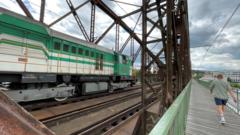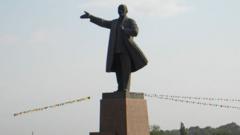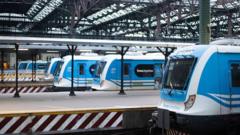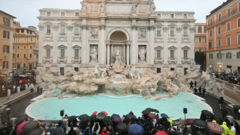In the picturesque city of Prague, known for its well-preserved architectural heritage, an intense debate has emerged over the future of the Vysehrad railway bridge. At 123 years old, this iconic structure is valued not only for its functionality but for the historical panorama it creates alongside the Vysehrad fortress—one of Prague's architectural marvels. As the Railway Authority proposes demolition and replacement, public outcry mounts, championed by concerned citizens and preservationists.
Architect Petr Tej, part of the Vysehrad Bridge Foundation, reflects on the bridge’s significance. “This bridge is pivotal to Prague’s identity,” he claims, nodding toward its rust-coated girder. Expressing concern over the proposed replacement, he insists, “The panorama of the Vysehrad fortress and this bridge rivals that of Charles Bridge and Prague Castle.” This sentiment has garnered the support of over 25,000 residents who demand restoration rather than costly and disruptive replacement.
The Vysehrad Bridge Foundation argues that the Railway Authority's assessment is alarmist. They suggest that only 15% of the bridge requires replacement, contrary to the Railway Authority's claim of 70%. Their proposal aims to preserve the historical integrity of the bridge while accommodating current railway demands, allowing continued operation without major disruptions. This approach has caught the attention of UNESCO, emphasizing the bridge's cultural significance.
However, the Railway Authority, represented by Pavel Paidar, cites a growing need for railway capacity as Prague’s train traffic is set to increase. "This bridge does not suffice for future transportation needs,” Paidar asserts, highlighting safety concerns due to corrosion and structural limitations that reduce the bridge's capacity.
The proposed substitution is designed to include an additional track that would aid the troubled transport network, revitalizing the surrounding area. The existing bridge would be relocated approximately 8 kilometers south to Modrany, where it would serve pedestrians and cyclists, effectively ending its original role as a central transport link.
Critics argue that relocating the bridge to Modrany—an area less suited for its style—could undermine its historical context. Tomas Bistricky, co-founder of the Vysehrad Bridge Foundation, believes that the goals of preserving the bridge and accommodating modern transport needs can actually coexist. “There’s a false dichotomy here,” he stresses, proposing a parallel bridge alongside the original to harmonize transport expansion with heritage conservation.
Thus, the dilemma continues: preserve historical landmarks or adapt to the demands of the modern world. In a city revered for its architectural conservation, this question will soon require a definitive answer from the Czech government, as citizens remain vigilant in the preservation of their cultural identity.





















